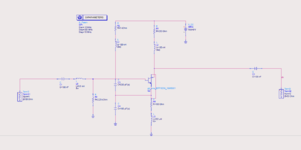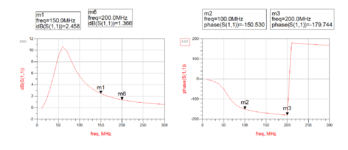Atif Hussain Shah
Member level 1
I am design an oscillator circuit for broad band range i-e from 100MHz to 200MHz.
The resonance frequency of the resonator changes from 100MHz to 200MHz as the Er of the substrate changes. The loss of resonator is around 4dB and its phase is around 150 to 170MHz.
With that resonator, I want to connect an amplifier in reflective mode so that the oscillator circuit completes.
The phase of amplifier is equal and opposite to the phase of Resonator so the phase condition of Bark-Hausten criteria is met but the gain of amplifier is less than the loss of resonator in 150 to 200MHz range. So Second condition of oscillator is not met in range 150 to 200MHz. The ciruit and response of Amplifier is attached below. How can I increase the gain to 4 dB. In full range(100 to 200MHz) of Amplifier.
@big Boss please help
The resonance frequency of the resonator changes from 100MHz to 200MHz as the Er of the substrate changes. The loss of resonator is around 4dB and its phase is around 150 to 170MHz.
With that resonator, I want to connect an amplifier in reflective mode so that the oscillator circuit completes.
The phase of amplifier is equal and opposite to the phase of Resonator so the phase condition of Bark-Hausten criteria is met but the gain of amplifier is less than the loss of resonator in 150 to 200MHz range. So Second condition of oscillator is not met in range 150 to 200MHz. The ciruit and response of Amplifier is attached below. How can I increase the gain to 4 dB. In full range(100 to 200MHz) of Amplifier.
@big Boss please help


